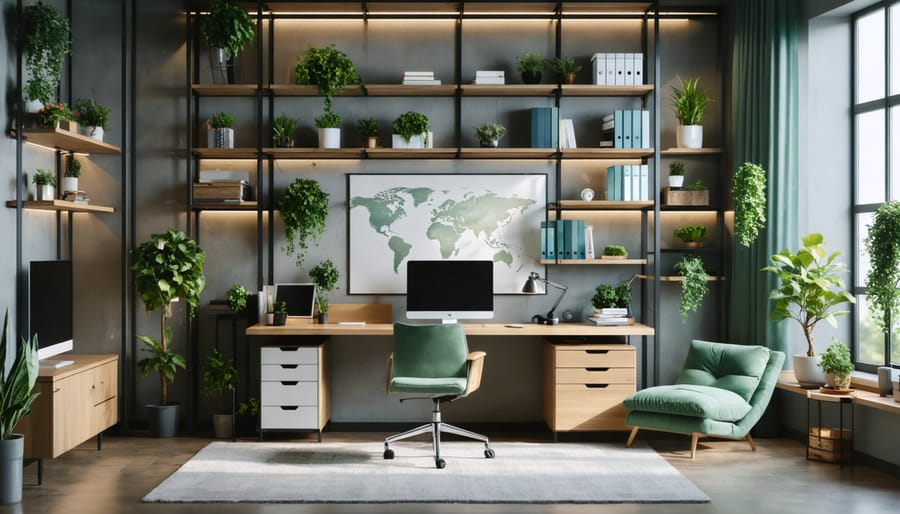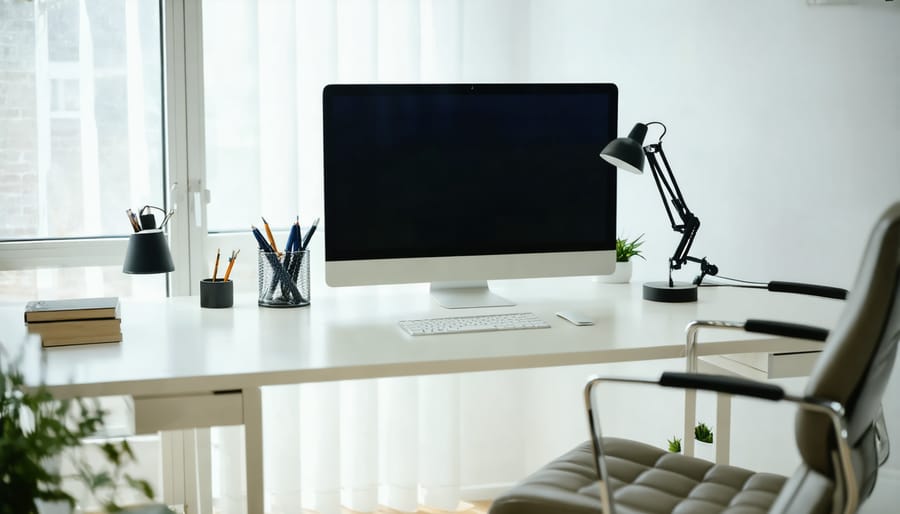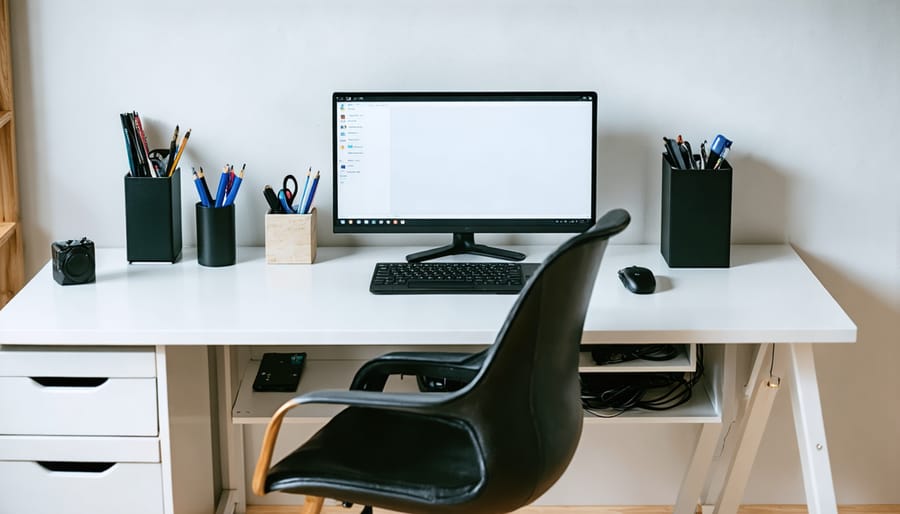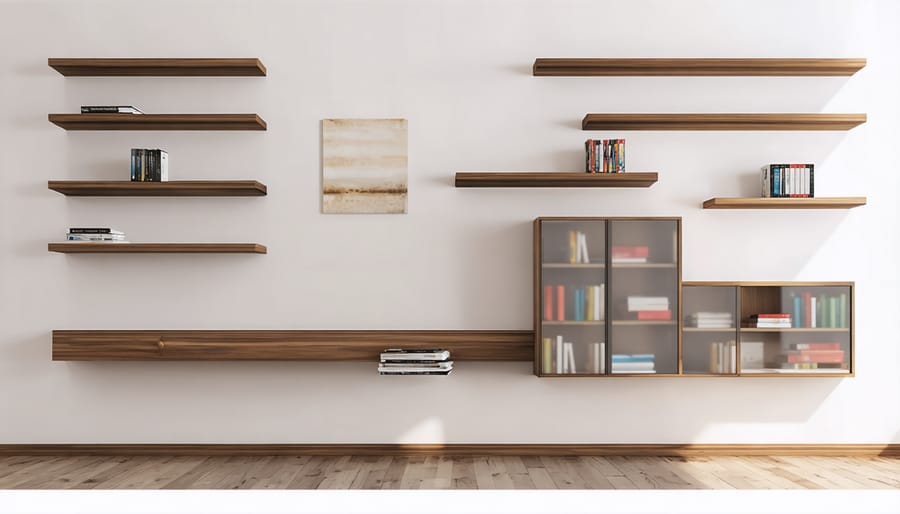
Transform Your Spare Room into a Productivity Powerhouse
Transform your home workspace into a productivity powerhouse by maximizing every square foot with smart, functional design choices. Create dedicated zones for focused work, client meetings, and storage to maintain a clutter-free environment that boosts efficiency. Position your desk near natural light sources while incorporating adjustable task lighting to reduce eye strain and enhance concentration during long work sessions. Integrate space-saving furniture like wall-mounted shelves, floating desks, and multi-purpose storage ottomans to maintain an organized, professional atmosphere without sacrificing valuable floor space. Select ergonomic furniture that supports proper posture and workflow, including a height-adjustable chair, keyboard tray, and monitor stand to prevent fatigue and increase comfort during extended work periods.
Smart Space Planning for Maximum Efficiency
The Work Triangle Concept
Just as a kitchen has its golden triangle for optimal functionality, your home office can benefit from a similar arrangement principle. When you maximize your small space, consider creating a work triangle between your three most-used areas: your desk, storage solutions, and technology hub.
Position your desk as the primary workspace, ideally facing a wall or window rather than a door to minimize distractions. Your storage area, whether it’s shelving or filing cabinets, should be within arm’s reach or require minimal movement to access. The technology hub – housing your printer, scanner, or charging station – should complete the triangle, positioned where cables can be neatly managed and devices are easily accessible.
The key is to keep frequently used items within a comfortable radius of your chair. Aim for no more than two to three steps between these main areas. This arrangement minimizes unnecessary movement, reduces fatigue, and helps maintain your productivity throughout the day. Remember to keep pathways clear and consider your natural workflow when arranging these elements.
Multi-Purpose Solutions
In today’s flexible work environment, making the most of your space means choosing furniture and arrangements that serve multiple purposes. A fold-down desk mounted to the wall can transform from a spacious workstation to a slim profile when not in use, perfect for small rooms or studio apartments. Consider investing in a desk with built-in storage that doubles as a vanity or entry table when you’re off the clock.
Ottoman seating with hidden storage compartments provides both extra seating for clients and a place to stash office supplies. Look for modular furniture systems that can be reconfigured based on your needs – think wheeled filing cabinets that can double as printer stands or side tables. A murphy bed with an integrated desk system allows your office to moonlight as a guest room without compromising workspace during business hours.
Room dividers on tracks or folding screens can section off your workspace during the day and easily slide away when you want to reclaim the space for family time. Smart storage solutions like floating shelves with hidden charging stations keep your space functional while maintaining a clean aesthetic.
Ergonomic Essentials That Won’t Break the Bank
Desk and Chair Optimization
Creating an ergonomic office setup starts with choosing the right desk and chair combination. Your desk should be at a height where your elbows rest at approximately 90 degrees when typing. For most people, this means a desk height between 28 and 30 inches, though adjustable-height desks offer the most flexibility.
When selecting an office chair, look for one with adjustable height, lumbar support, and armrests. Your feet should rest flat on the floor with your thighs parallel to the ground. If needed, use a footrest to achieve this position. The chair’s backrest should support your natural spine curve, and armrests should allow your shoulders to remain relaxed.
Consider the depth of your desk – you’ll want enough space to position your monitor at arm’s length (about 20-28 inches from your eyes) while maintaining room for your keyboard and mouse. A desk depth of at least 30 inches is recommended for comfortable viewing and typing distances.
For extra comfort, add cushioning to your chair if needed, and ensure there’s enough clearance under your desk for leg movement. Remember to stand up and stretch every hour, regardless of how comfortable your setup is. The best furniture arrangement is one that encourages movement throughout the day while maintaining proper posture during focused work periods.

DIY Ergonomic Upgrades
Creating an ergonomic workspace doesn’t have to break the bank. Start with your chair by adding a lumbar support cushion or rolling up a small towel to support your lower back. For under $20, you can craft a monitor stand using sturdy books or a wooden shelf to bring your screen to eye level, preventing neck strain.
Transform any desk into a standing desk by creating a simple riser using stable boxes or crates. Place a solid board across them to make a elevated surface for your laptop or monitor. For your wrists, make a DIY keyboard wrist rest using a small rolled towel or by filling a fabric tube with rice or beans.
Don’t forget your feet! A footrest is essential for proper posture, and you can easily create one using a firm cushion, a small box, or even a stack of old textbooks wrapped in fabric. If you’re experiencing wrist discomfort while using your mouse, create a sloped mouse pad by placing a thin book under one end of your existing pad.
For document holders, repurpose cookbook stands or create your own using a wire coat hanger bent into shape. Keep your workspace clutter-free with DIY cable management solutions using binder clips on your desk edge or toilet paper rolls in a shoebox to organize cords.
Remember to test these modifications for stability before fully implementing them, and adjust as needed for your comfort.
Tech Integration Without the Clutter
Cable Management Solutions
A clutter-free workspace starts with taming those unruly cables and cords. Begin by conducting a cable audit – identify which cords are essential and remove any that aren’t in use. For desk-mounted solutions, invest in cable management trays that attach under your desk, keeping wires organized and out of sight. Cable sleeves or spiral wrap tubes can bundle multiple cords together, creating a cleaner look while protecting your cables.
Make the most of your desk grommets by using them as cable pathways, and consider installing adhesive cable clips along the desk’s edge or underside to guide wires where you want them. For power strips and adapters, mount them under your desk using brackets or Velcro strips to keep them accessible but hidden. When integrating smart home office technology, use cord covers that match your wall color to conceal cables running to wall-mounted screens or equipment.
For floor-based solutions, consider decorative cable management boxes to hide power strips and excess cord length. These boxes not only organize cables but also protect them from dust and accidental kicks. Label your cords using colored zip ties or custom labels to easily identify them when maintenance is needed.

Smart Storage for Devices
In today’s digital workspace, managing multiple devices efficiently is crucial for maintaining a clutter-free home office. Start by investing in a charging station dock that can accommodate your smartphone, tablet, and wireless earbuds simultaneously. These compact organizers not only keep your devices powered but also create a designated home for each gadget.
Consider installing a cable management system under your desk using adhesive cable clips or a mesh tray. This simple addition keeps power cords, USB cables, and charging wires neatly bundled and easily accessible. For extra convenience, mount a power strip to the underside of your desk to keep outlets within reach while maintaining a clean aesthetic.
Create a tech drawer system using adjustable dividers to store less frequently used devices, external hard drives, and spare cables. Label each compartment clearly to avoid the dreaded cable-hunting expedition. For vertical storage, wall-mounted shelving units with built-in cable management can house your router, printer, and other office equipment while keeping your desk space free.
Don’t forget about portable devices you use occasionally. A dedicated tech basket or bin can store items like portable chargers, card readers, and adapters, making them easy to find when needed.
Storage Solutions That Actually Work
Vertical Space Maximization
When space is at a premium, looking up can reveal a wealth of untapped potential in your home office. Vertical storage solutions not only maximize your available square footage but also keep essential items within arm’s reach while maintaining a clutter-free desk space.
Start by installing floating shelves at varying heights to create a dynamic storage system. These versatile additions can house everything from reference books and file boxes to decorative items that inspire creativity. Consider mounting a pegboard wall panel, which offers flexible storage options for office supplies, calendars, and frequently used tools.
Take advantage of the often-overlooked space behind your door by installing an over-the-door organizer or hooks for hanging bags, coats, or additional storage bins. Wall-mounted file holders can keep important documents organized and easily accessible without taking up precious desk space.
For tech-savvy professionals, vertical cable management systems can be integrated into your wall setup, keeping cords tidy and out of sight while maximizing outlet accessibility. Consider installing a wall-mounted monitor arm to free up desk space and achieve optimal screen positioning.
Don’t forget the corners! Corner shelving units or floor-to-ceiling bookcases can transform these traditionally underutilized spaces into productive storage areas. For a polished look, opt for matching storage containers or baskets that complement your office décor while keeping smaller items organized and dust-free.
Remember to leave some breathing room between storage elements to prevent the space from feeling cramped or overwhelming. The key is to strike a balance between functionality and visual appeal.

Hidden Storage Tricks
Smart storage solutions can make or break a home office, and the trick is to think beyond traditional filing cabinets. Consider installing floating shelves that double as display spaces for both decorative items and frequently used supplies. These not only maximize vertical wall space but also keep your desk area clutter-free.
Make use of dead space by adding under-desk drawers or a rolling cart that can tuck away neatly when not in use. A hollow ottoman can serve as both extra seating for clients and a secret storage spot for rarely-used items. For those tight on space, look into desk options with built-in storage compartments or cable management systems.
Get creative with door-mounted organizers or behind-the-door shelving units – these often-overlooked spaces can house office supplies, files, or even tech accessories. Consider installing a pegboard wall that can be customized with hooks, shelves, and containers to create a flexible storage system that grows with your needs.
Don’t forget about corner spaces – a corner shelf unit or custom-built storage solution can transform these awkward areas into functional storage zones. For a clean aesthetic, opt for storage boxes and baskets in coordinating colors or materials that complement your office decor. Label everything clearly but elegantly to maintain both organization and style.
Remember, the key is to integrate storage seamlessly into your office design so it enhances rather than detracts from your workspace’s overall appeal.
Lighting for Productivity and Comfort
Lighting plays a crucial role among the essential elements of a quality workspace, directly impacting both your productivity and well-being. Start by maximizing natural light in your home office by positioning your desk near a window, but angle it to prevent glare on your screen. If natural light is limited, layer your artificial lighting using three key elements: ambient, task, and accent lighting.
For ambient lighting, opt for ceiling-mounted fixtures or floor lamps that provide even, overall illumination. Choose LED bulbs in the 4000K-5000K range for a crisp, daylight-like effect that helps maintain alertness during work hours. Task lighting is crucial for detailed work – invest in an adjustable desk lamp with multiple brightness settings and a flexible arm to direct light exactly where you need it.
Consider installing dimmer switches to adjust light levels throughout the day, matching your circadian rhythm and different work activities. Smart bulbs can be particularly useful, allowing you to program lighting changes and even sync with your calendar for video calls.
Remember to position lights to minimize shadows and reduce eye strain. Place task lighting on the opposite side of your writing hand to prevent casting shadows, and ensure your screen brightness balances with the room’s lighting to reduce visual fatigue. For video conferences, add a small light positioned behind your monitor to illuminate your face evenly.
If you’re dealing with harsh overhead lighting, consider using light diffusers or replacing stark bulbs with softer options. Small accent lights can add warmth to your space while providing subtle background illumination for early morning or evening work sessions.
Creating a functional home office doesn’t have to be overwhelming or expensive. By focusing on key elements like proper lighting, ergonomic furniture, efficient storage solutions, and smart space planning, you can transform any area into a productive workspace. Remember that the perfect home office is one that suits your specific needs and working style.
Start with small changes, like repositioning your desk for better natural light or adding organizational tools to keep your workspace clutter-free. Consider implementing some of the storage solutions and technology integrations we’ve discussed to boost your productivity and comfort. Even simple additions like a good task light or an ergonomic chair can make a significant difference in your daily work experience.
Don’t be afraid to personalize your space while maintaining functionality. The beauty of a home office is that it can reflect both your professional needs and personal style. Take action today by choosing one or two ideas from this guide and putting them into practice. Your perfect home office awaits, and with these practical solutions, you’re well-equipped to create a space that promotes both productivity and wellbeing.
